The History of the Breitling Top Time
The History of the Breitling Top Time
Today, Breitling's Top Time, along with other Breitling watches, are recognized as the finest watches of their time, and the Top Time in particular has deep ties to the aviation and auto racing worlds.
Breitling had deep ties to the aviation industry, having agreements with airlines and aircraft manufacturers that used its chronograph watches as standard equipment.
The Top Time series, which began production in the Swiss factory in La Chaux-de-Fonds in the 1950s, has a similar connection.
The Top Time series, which began production in the Swiss factory in La Chaux-de-Fonds in the 1950s, has a similar connection.
Breitling's relationship with aviation began under the leadership of Willy Breitling, grandson of founder Leon Breitling.
Willy took over in 1932 and continued to develop aviation chronographs, supplying the Royal Air Force.
This agreement marked the beginning of the popularity of the company's watches and the global success of Breitling.
Willy took over in 1932 and continued to develop aviation chronographs, supplying the Royal Air Force.
This agreement marked the beginning of the popularity of the company's watches and the global success of Breitling.
Its popularity showed no signs of slowing, and Breitling continued to produce the Top Time for many years after the introduction of the automatic chronograph in the late 1960s.
Production of the Breitling Top Time ceased in the late 1970s.
This was almost 20 years after its original release.
Unfortunately, Breitling doesn't release information about production numbers, so there's no way of knowing how many watches actually made it onto the market.
Production of the Breitling Top Time ceased in the late 1970s.
This was almost 20 years after its original release.
Unfortunately, Breitling doesn't release information about production numbers, so there's no way of knowing how many watches actually made it onto the market.
Top Time Design
Breitling designed the Top Time specifically to target young people under the age of 25.
In this market, watchmakers recognized that the chronograph was a watch aimed at sports and technology enthusiasts, watch enthusiasts and people with an active lifestyle.
The watch was advertised as a "dashboard" that could be worn on a young man's wrist and featured a tachymeter mounted on the outer rim of the watch to measure speed and distance.
In this market, watchmakers recognized that the chronograph was a watch aimed at sports and technology enthusiasts, watch enthusiasts and people with an active lifestyle.
The watch was advertised as a "dashboard" that could be worn on a young man's wrist and featured a tachymeter mounted on the outer rim of the watch to measure speed and distance.
Willy Breitling said of the Top Time in 1964: "We are familiar with and understand the world of young people's interests. This particular model is especially suited to the needs of young, active professionals from all walks of life.
The Top Time is a new and groundbreaking model."
The Top Time is a new and groundbreaking model."
While the essence of the Top Time is undoubtedly a sports watch, its "bold new lines," "air of rareness and individuality," and elegance made it extremely popular with young women.
The Top Time also gained a following as an elegant dress watch.
Commenting on this popularity, Breitling said, "The young man or woman who buys a Top Time need not be an expert in chronometry."
The Top Time also gained a following as an elegant dress watch.
Commenting on this popularity, Breitling said, "The young man or woman who buys a Top Time need not be an expert in chronometry."
dial
Breitling offers a wide range of dial colors, producing seven different color variations.
The Top Time features small seconds, 30-minute and 45-minute counters, or subdials for 60 seconds, 30 minutes and 12 hours.
On the dial, the Breitling logos "Breitling" and "Geneva" are placed at the 12 o'clock position, and the "Top Time" logo is placed at the 6 o'clock position.
However, the Top Time logo is not found on the reference numbers 815 and 814. The speedometer display is used on all models.
The Top Time features small seconds, 30-minute and 45-minute counters, or subdials for 60 seconds, 30 minutes and 12 hours.
On the dial, the Breitling logos "Breitling" and "Geneva" are placed at the 12 o'clock position, and the "Top Time" logo is placed at the 6 o'clock position.
However, the Top Time logo is not found on the reference numbers 815 and 814. The speedometer display is used on all models.
The Top Time is equipped with indexes and obelisk hands, but the model 2007-33 uses dauphine hands.
The index is generally displayed in a linear format, except for model numbers 824, 1765, and 7656.
The 824 model had Roman numerals, while the 1765 and 7656 had stick markers. Breitling used tritium for its luminous versions.
The index is generally displayed in a linear format, except for model numbers 824, 1765, and 7656.
The 824 model had Roman numerals, while the 1765 and 7656 had stick markers. Breitling used tritium for its luminous versions.
Top Time Panda Series
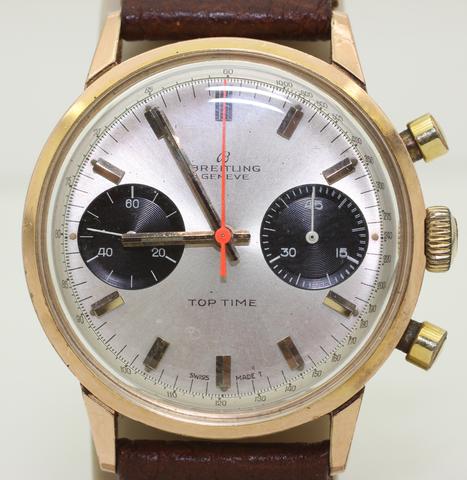
The Panda series features a silver main dial and black subdials.
The most common theory is that this color combination and subdial arrangement resembles a panda's face.
The "Reverse Panda" variation features a black main dial and white subdials.
Another variation is known as the “Panda Bear” or “True Panda” and features a white main dial and black subdials.
The most common theory is that this color combination and subdial arrangement resembles a panda's face.
The "Reverse Panda" variation features a black main dial and white subdials.
Another variation is known as the “Panda Bear” or “True Panda” and features a white main dial and black subdials.
Of the three models, the Reverse Panda was released first in 1964, followed by the True Panda and then the Panda.
Breitling is believed to have first introduced the reverse panda style with its Superocean Chronograph, Model 807, in 1957.
Then, in the early 1960s, the AVI Co-Pilot model 765 entered the market.
TAG Heuer followed suit with the Autavia in 1962, and Rolex with the Cosmograph in 1963.
In the same year, Breitling's popular Navitimer model 806 also adopted the reverse panda design.
Breitling is believed to have first introduced the reverse panda style with its Superocean Chronograph, Model 807, in 1957.
Then, in the early 1960s, the AVI Co-Pilot model 765 entered the market.
TAG Heuer followed suit with the Autavia in 1962, and Rolex with the Cosmograph in 1963.
In the same year, Breitling's popular Navitimer model 806 also adopted the reverse panda design.
However, Rolex took the lead in true panda design, releasing the Cosmograph Daytona, model 6239, in 1963.
Breitling's True Panda model debuted in 1966, TAG Heuer's Carrera was released in 1968, and Zenith's El Primero A384 in 1969.
Zenith also released its first three-color panda model, reference number A386, in the same year.
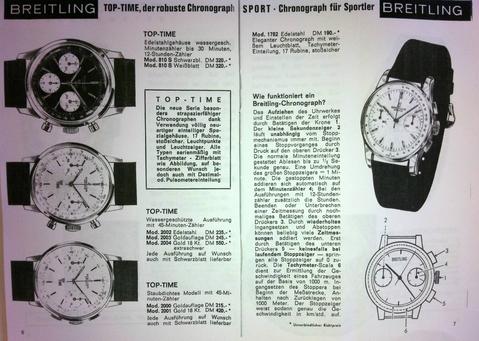
Breitling's True Panda model debuted in 1966, TAG Heuer's Carrera was released in 1968, and Zenith's El Primero A384 in 1969.
Zenith also released its first three-color panda model, reference number A386, in the same year.

This photo was taken in the 1964 Breitling catalog, which first introduced the Panda series of the Top Time.
Top Time Long Playing
Long Playing refers to the Top Time series, which has a longer mainspring function than normal, allowing for a power reserve of up to 52 hours. The Top Time Long Playing models are model numbers 810.3, 810.4, 824.3, and 824.4.


The photo above was published in a 1969 catalogue.
Breitling Top Time Racing
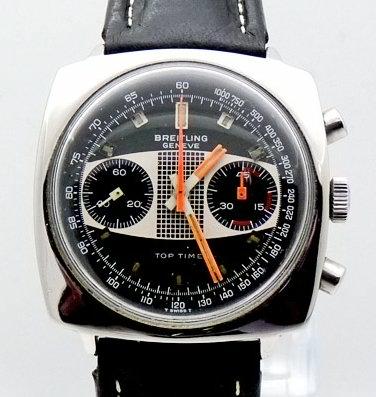
The Top Time Racing refers to the model number 2211 and is characterized by a checkered pattern in the center of the dial and retro-style orange hands.
This particular model comes with a stainless steel cushion-shaped case measuring approximately 38 mm in diameter and a black dial with the same design as the velodrome.
Case, jewels, bezel
Top Time watches are available with round or cushion cases made of stainless steel, white metal, 18-karat gold, or gold-plated gold.
The company began production using cushion-shaped cases in the late 1960s and only used them for model numbers 2006, 2007, 2008, 2009, and 810.
Case sizes were approximately 35mm to 40mm.
The crystal is made of Plexiglas or an acrylic dome, and with the exception of the 1765 and 7656 models, Top Time watches do not have a bezel.
The company began production using cushion-shaped cases in the late 1960s and only used them for model numbers 2006, 2007, 2008, 2009, and 810.
Case sizes were approximately 35mm to 40mm.
The crystal is made of Plexiglas or an acrylic dome, and with the exception of the 1765 and 7656 models, Top Time watches do not have a bezel.
The case back, on the other hand, seems to vary depending on the model, particularly whether the watch is waterproof.
For example, models 2001 and 2002 are waterproof and have a removable back, while model 2003 is not waterproof and has a monocoque construction.
Although the case structures are different, the non-waterproof model has a modified back cover, so both models look nearly identical.
Top Time model number
-Model number 2000
Model number 2000-3


The Breitling Top Time, reference number 2000-33, which appeared in the 1960s came in reverse panda (left) and panda (right).
Model number 2000.4
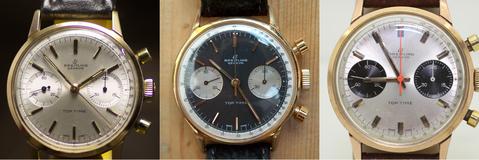
The water-resistant Breitling Top Time, model 2000.4, released in 1964 was available with three different dial variations.
One (left) featured a silver sunburst dial with matching subdials, while there were also reverse panda (center) and panda (right) variations.
One (left) featured a silver sunburst dial with matching subdials, while there were also reverse panda (center) and panda (right) variations.
-Model number 2001
Model number 2001.5
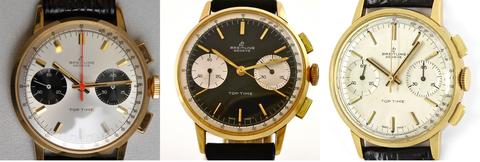

The 1968 Top Time Ref. 2001 was released in only one model, the 2001.5, with three dial options: panda (left), reverse panda (center), and white main and subdials (right).
All of the cases are non-waterproof 18-karat gold and the movement is the Valjoux 7733.
-Model number 2002
All of the cases are non-waterproof 18-karat gold and the movement is the Valjoux 7733.
-Model number 2002
Model number 2002-3


The Top Time, Ref. 2002-33, is powered by the Valjoux 7733 movement housed in a round, waterproof stainless steel case.
There were two dial variations: panda and reverse panda.
There were two dial variations: panda and reverse panda.
Model number 2002.3

The Top Time Ref. 2002.3 was also available with two dial variations.
One (left) has a silver sunburst main dial with matching subdials, while the other (right) has silver subdials and a black main dial.
The case was made of rounded stainless steel and was waterproof, and it was powered by the Valjoux 7730 movement.
One (left) has a silver sunburst main dial with matching subdials, while the other (right) has silver subdials and a black main dial.
The case was made of rounded stainless steel and was waterproof, and it was powered by the Valjoux 7730 movement.
-Model number 2003
Model number 2003.4
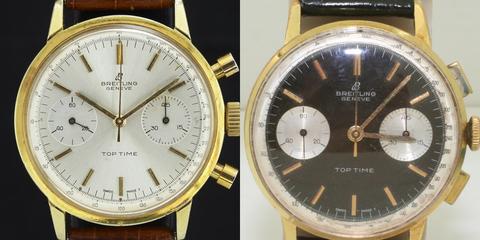

The Top Time, reference number 2003.4, which was introduced in 1964, had a round, gold-plated, non-waterproof case and was equipped with the early Venus 188 movement. It was available with two dial variations.
One had a silver sunburst main dial with subdials of the same color (left), and the other had a reverse panda (right).
One had a silver sunburst main dial with subdials of the same color (left), and the other had a reverse panda (right).
-Model number 2004
Model number 2004.5
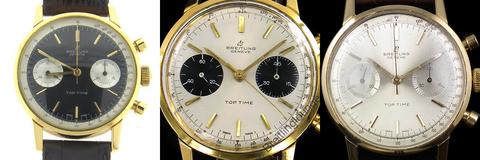
The Top Time Ref. 2004.5 was released in 1976 and featured a Valjoux 7730 movement housed in a waterproof 18k gold case.
There were three dial variations: reverse panda (left), panda (centre), and a silver sunburst main dial and subdials (right).
There were three dial variations: reverse panda (left), panda (centre), and a silver sunburst main dial and subdials (right).
-Model number 2006
Model number 2006.3
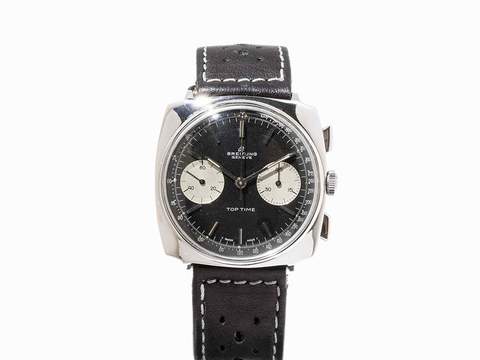
The Top Time Ref. 2006.3 is fitted with a Valjoux 7730 movement housed in a stainless steel cushion case.
The dial features a black main dial and silver sub-dials.
The dial features a black main dial and silver sub-dials.
Model number 2006-33
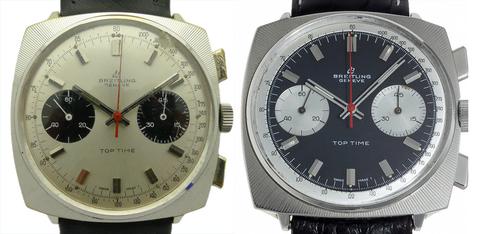

The Top Time model 2006-33 is equipped with the Valjoux 7730 and uses the same case as the model 2006.3.
There were two dial options: Panda (left) and Reverse Panda (right).
There were two dial options: Panda (left) and Reverse Panda (right).
-Model number 2007
Model number 2007-33
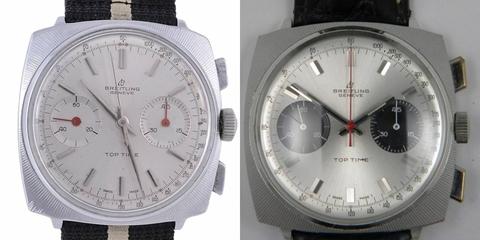
The Top Time, Ref. 2007-33, features a 35 mm diameter, embossed white metal cushion case.
The case houses the same Valjoux 7730 movement as the chronograph.
There are two dials available: a panda (right) and a silver sunburst main dial and subdials (left).
The case houses the same Valjoux 7730 movement as the chronograph.
There are two dials available: a panda (right) and a silver sunburst main dial and subdials (left).
Model number 2007.1
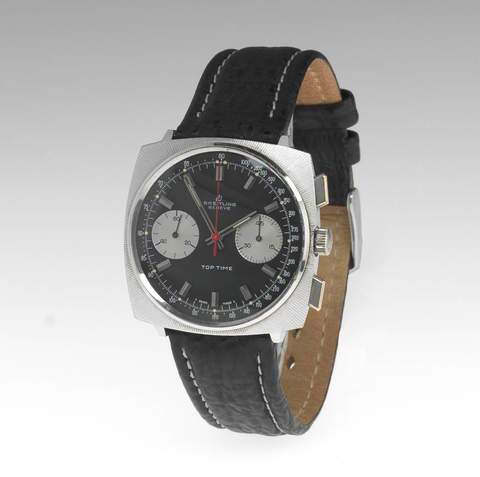

Unlike the 2007-33, the 2007.1 was only produced with a reverse panda dial.
However, it has the same 35 mm machined white metal cushion case and Valjoux 7730 movement.
However, it has the same 35 mm machined white metal cushion case and Valjoux 7730 movement.
-Model number 2008
Model number 2008.4

The early Breitling Top Time Ref. 2008.4, released in 1967, used the Venus 188 movement, which was later changed to the Valjoux 7730.
The dial is available in three varieties: panda, reverse panda, and silver sunburst main dial and subdials.
The dial is available in three varieties: panda, reverse panda, and silver sunburst main dial and subdials.
Model number 2008-3
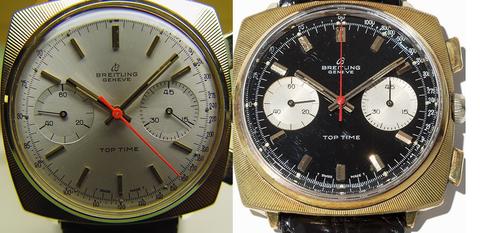

The Top Time, model number 2008-33, which was introduced in 1969, features a gold-plated cushion case with an ornate scalloped design.
This model comes in two variations: a reverse panda (right) and a silver sunburst main dial and subdials (left).
This model comes in two variations: a reverse panda (right) and a silver sunburst main dial and subdials (left).
Model number 2008.3
The model 2008.3, introduced to the market in 1968, was available in only one design: the panda.
-Model number 2009
Model number 2009.4


The Top Time Ref. 2009.4 was introduced with a "Racing Look" dial (far left).
It is also available in regular panda (second from the left), reverse panda (far right), and with a silver sunburst main dial and sub-dial (second from the right).
All variants came with a 36.6 mm gold-plated cushion case.
Model number 2009-33
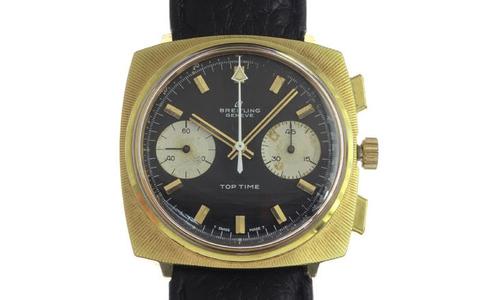
It is also available in regular panda (second from the left), reverse panda (far right), and with a silver sunburst main dial and sub-dial (second from the right).
All variants came with a 36.6 mm gold-plated cushion case.
Model number 2009-33

Model number 2009-33 used the same case as 2009.4.
It was sold in one version, using the Valjoux 7730 movement and featuring silver subdials and a black main dial.
It was sold in one version, using the Valjoux 7730 movement and featuring silver subdials and a black main dial.
-Model number 810
Model number 810.3


The Breitling Top Time Ref. 810.3 used the Venus 178 with its sub-second pillar wheel.
The movement is housed in a 38 mm round stainless steel case with a Plexiglas crystal.
There were three dial variations: panda (center), reverse panda (right), and a silver sunburst main dial and subdials (left).
The movement is housed in a 38 mm round stainless steel case with a Plexiglas crystal.
There were three dial variations: panda (center), reverse panda (right), and a silver sunburst main dial and subdials (left).
Model number 810.4
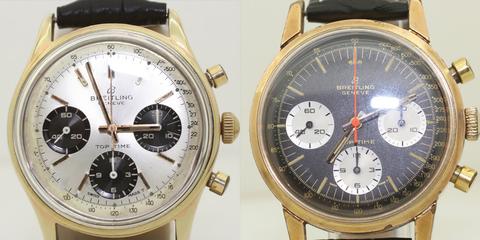

The 810.4 model was released one year after the 810.3 in 1967.
It used the same case as the 810.3, but had one less dial option: Panda (left) and Reverse Panda (right).
It used the same case as the 810.3, but had one less dial option: Panda (left) and Reverse Panda (right).
Model number 814
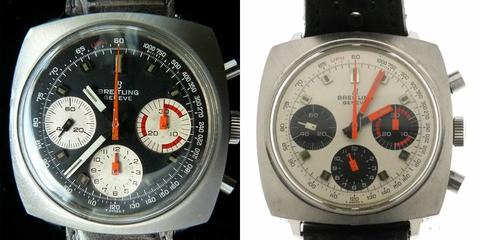

The Model 814 used the Venus caliber 178, an early Top Time movement.
It features a stainless steel screw-back cushion case and pop orange hands.
Some see this model as the first step in the transition from the relatively dark monochromatic and bicolor schemes of the 1960s to the more colorful and "progressive" 1970s.
This model is available in two dial variations.
One has a black main dial with white subdials (left), and the other has a white sunburst main dial with black subdials (right).
It features a stainless steel screw-back cushion case and pop orange hands.
Some see this model as the first step in the transition from the relatively dark monochromatic and bicolor schemes of the 1960s to the more colorful and "progressive" 1970s.
This model is available in two dial variations.
One has a black main dial with white subdials (left), and the other has a white sunburst main dial with black subdials (right).
Model number 815
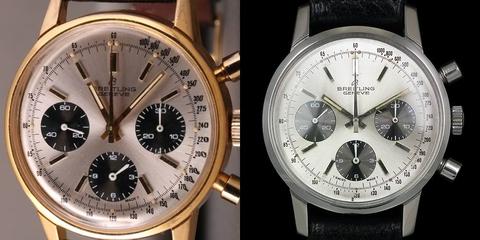

The Top Time reference number 815 first appeared in the 1970 catalogue.
It has a stainless steel snap-back round case that houses the Valjoux 7736 movement.
It features a silver sunburst main dial with three black subdials.
It has a stainless steel snap-back round case that houses the Valjoux 7736 movement.
It features a silver sunburst main dial with three black subdials.
-Model number 824
Model number 824-3
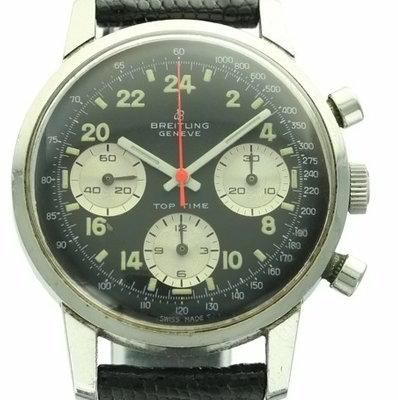

The Top Time model number 824.3 is fitted with the Venus 178 movement in a waterproof stainless steel round case.
The dial was only available in reverse panda.
The dial was only available in reverse panda.
Model number 824.4
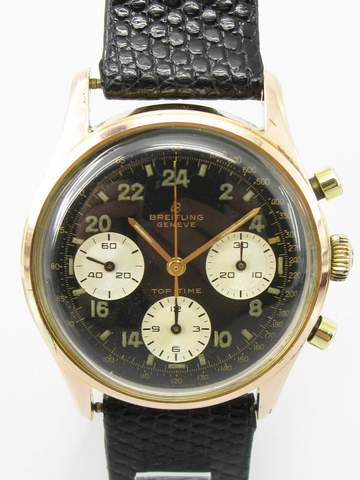

The Top Time reference 824.4 was also waterproof, but unlike the 824-3, it had a gold-plated round case.
Also, it was only available in a white design with a black main dial for 24 hours.
Also, it was only available in a white design with a black main dial for 24 hours.
-Model number 1765


The Top Time reference number 1765 is also known as the Jean-Claude Killy, after the famous alpine skier who owned it.
The Top Time is housed in a large 42mm stainless steel case and is powered by the Valjoux 7736 movement.
It features a black dial with three white subdials and a bezel.
The Top Time is housed in a large 42mm stainless steel case and is powered by the Valjoux 7736 movement.
It features a black dial with three white subdials and a bezel.
-Model number 2211


The Top Time Ref. 2211 used a 38 mm case that was slightly smaller than the 1765 but still larger than the other models in the Top Time series.
It used the Venus 188 movement inside a stainless steel case.
The dial of one of the 2211 models has a checkered design and is known as the Breitling Top Time Racing (third from the left).
The colorful hands are also a feature of this model.
It used the Venus 188 movement inside a stainless steel case.
The dial of one of the 2211 models has a checkered design and is known as the Breitling Top Time Racing (third from the left).
The colorful hands are also a feature of this model.
-Model number 7646


The Top Time reference number 7656 features a 12-hour rotating bezel.
Only two models in this series incorporate this feature.
Another Top Time that uses a bezel is reference number 1765. It features three white subdials and a black main dial.
The Breitling Top Time is a watch series characterized by its bold and elegant design, and has been highly valued by professional pilots and racers.
The watch was launched in 1964 as a strategy aimed primarily at young men.
Breitling Top Time watches were positioned as entry-level chronographs, priced much lower than the company's top-of-the-line Navitimer and Chronomat watches.
It gradually gained popularity and is now a staple item among watch enthusiasts.
Many celebrities in entertainment and sports have been known to wear the Breitling Top Time, making the watch a part of pop culture.
In the film, Connery played an agent tasked with locating two NATO atomic bombs that had been stolen by the criminal organisation SPECTRE.
Bond's boss, Q (Desmond Llewelyn), gifts Bond with a Breitling Top Time, Model 2002, equipped with a Geiger counter.
Bond wore the watch in various scenes, including during his radiological investigations on the Disco Volante boat and at the Nassau Palmyra mansion, where a stolen bomb was hidden.
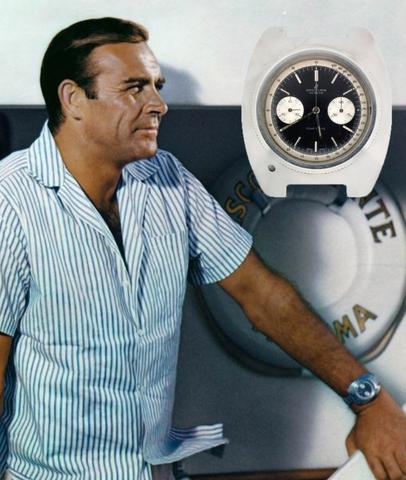
Sean Connery only wore two watches while playing James Bond, including the Top Time.
The other watch is the Rolex Submariner 6538, which was used in "Goldfinger," "From Russia with Love," "Dr. No," and "Thunderball."
The Top Time 2002 is famous as the first watch modified by Q, but there are other watches that will also be featured.
The Breitling Navitimer Ref. 806 is worn by NATO pilot Major Delval (Paul Stassino), brother of Dominique “Domino” Delval (Claudine Auger).
Actor and comedian Sid James also wore a Top Time in the 1973 film "Carry on Girls," but the Breitling Top Time Panda he wore never got a nickname named after him or the movie.
Killy is said to have worn the watch before, during and after the 1968 Olympics.
He also reportedly wore the same watch while racing.
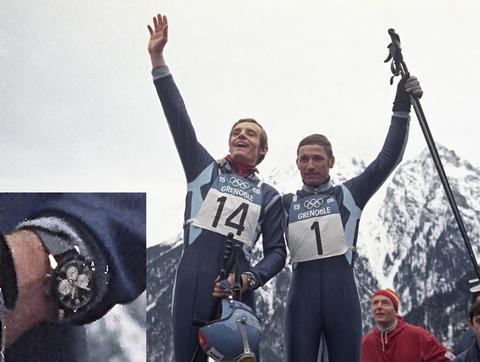
Also among the sporting luminaries associated with top times is Scottish Formula One racer James “Jim” Clark.
The Model 810 was mistakenly nicknamed the Clark.
Breitling watch enthusiasts have fiercely debated whether Clark owned a Top Time, with some Breitling experts arguing that photographs show he was wearing an Enicar Sherpa Graf rather than a Top Time.
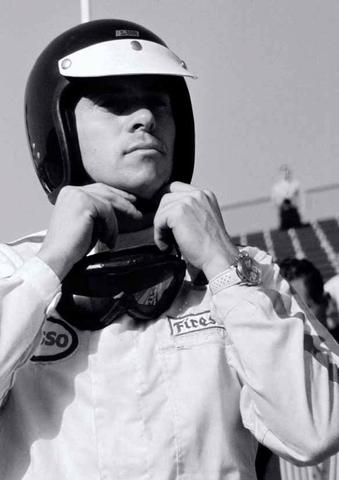
Only two models in this series incorporate this feature.
Another Top Time that uses a bezel is reference number 1765. It features three white subdials and a black main dial.
Top Time: A favorite among actors and athletes
The Breitling Top Time is a watch series characterized by its bold and elegant design, and has been highly valued by professional pilots and racers.
The watch was launched in 1964 as a strategy aimed primarily at young men.
Breitling Top Time watches were positioned as entry-level chronographs, priced much lower than the company's top-of-the-line Navitimer and Chronomat watches.
It gradually gained popularity and is now a staple item among watch enthusiasts.
Many celebrities in entertainment and sports have been known to wear the Breitling Top Time, making the watch a part of pop culture.
The Top Time used in the movie
The most famous of these celebrities is Sean Connery, the actor who played James Bond in the 1965 007 film series Thunderball.In the film, Connery played an agent tasked with locating two NATO atomic bombs that had been stolen by the criminal organisation SPECTRE.
Bond's boss, Q (Desmond Llewelyn), gifts Bond with a Breitling Top Time, Model 2002, equipped with a Geiger counter.
Bond wore the watch in various scenes, including during his radiological investigations on the Disco Volante boat and at the Nassau Palmyra mansion, where a stolen bomb was hidden.

Sean Connery only wore two watches while playing James Bond, including the Top Time.
The other watch is the Rolex Submariner 6538, which was used in "Goldfinger," "From Russia with Love," "Dr. No," and "Thunderball."
The Top Time 2002 is famous as the first watch modified by Q, but there are other watches that will also be featured.
The Breitling Navitimer Ref. 806 is worn by NATO pilot Major Delval (Paul Stassino), brother of Dominique “Domino” Delval (Claudine Auger).
Actor and comedian Sid James also wore a Top Time in the 1973 film "Carry on Girls," but the Breitling Top Time Panda he wore never got a nickname named after him or the movie.
Top times in sports
In the sports world, Jean-Claude Killy, who competed in the Olympic alpine skiing competition for France, became famous as the owner of a Breitling Top Time, reference number 1765, and the watch was nicknamed "Jean-Claude Killy."Killy is said to have worn the watch before, during and after the 1968 Olympics.
He also reportedly wore the same watch while racing.

Also among the sporting luminaries associated with top times is Scottish Formula One racer James “Jim” Clark.
The Model 810 was mistakenly nicknamed the Clark.
Breitling watch enthusiasts have fiercely debated whether Clark owned a Top Time, with some Breitling experts arguing that photographs show he was wearing an Enicar Sherpa Graf rather than a Top Time.




